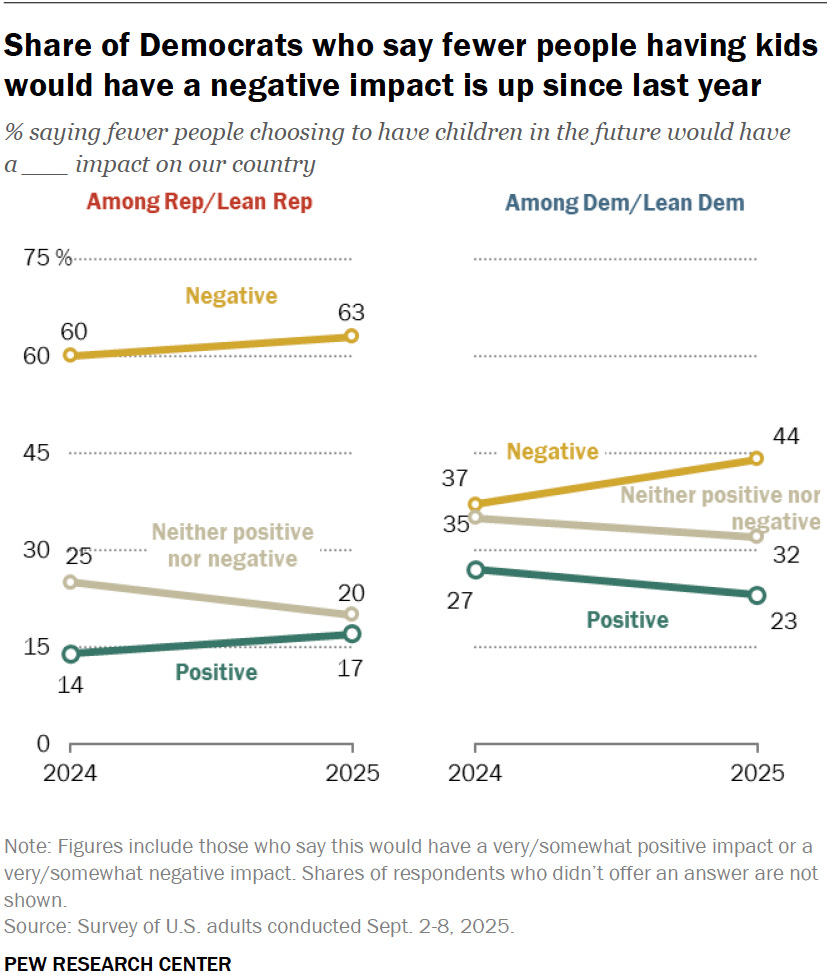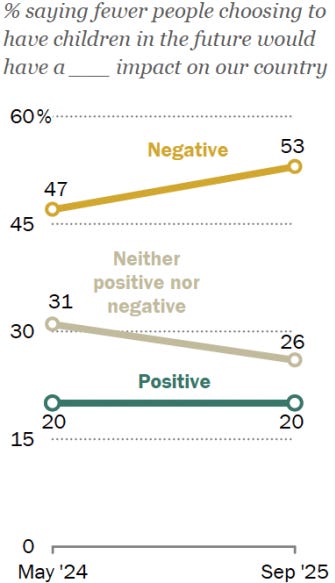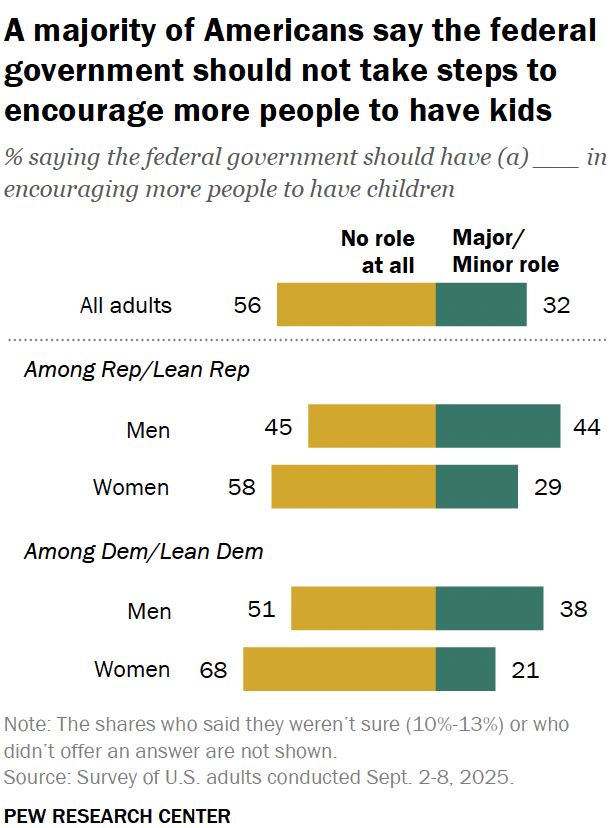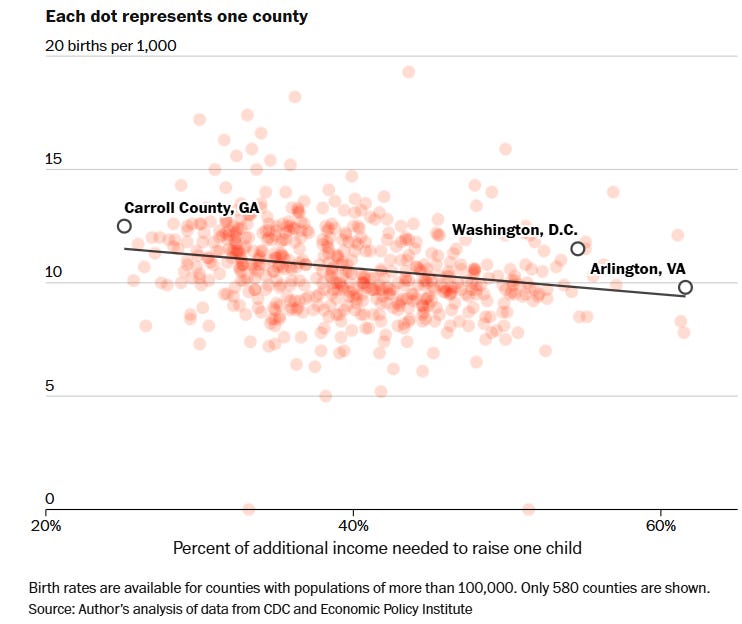Repronews #75: Most Americans now say low fertility is bad for the country
AI automating conception | a conservative case for reprotech | drivers of U.S. fertility decline | genetic study of Alzheimer’s in African Americans
Welcome to the latest issue of Repronews! Highlights from this week’s edition:
Repro/genetics
The Washington Post reports on how AI and robotics are being used to automate human conception.
Jonathan Anomaly makes a conservative case for reprogenetic technologies, arguing these are needed to stem the accumulation of harmful mutations.
Population Policies & Trends
53% of Americans now say having fewer children is bad for the country, but 56% also say the federal government should not try to increase births.
Research suggests declining religiosity and the costs of housing and childcare are driving U.S. fertility decline.
The UN Population Fund calls for “greater reproductive agency” by supporting access to contraception and fertility services.
Genetic Studies
Large study of African Americans discovers numerous genes involved in Alzheimer’s disease.
Further Learning
Repro/genetics
“Robots are learning to make human babies: 20 have already been born” (Washington Post)
AI-enabled robotics are being trialed to automate IVF procedires, using computer-vision to select sperm and robotic arms to perform fertilization.
At least 20 babies have reportedly been born via such automated protocols in clinical trials over the past three years. Early results generally match average manual IVF performance.
Reprotech startups are commercializing automation modules for IVF and egg freezing in parts of Latin America and Turkey. These are often not yet FDA-approved in the U.S.
The WHO estimates 1 in 6 people experience infertility globally. Access to fertility care is limited and underfunded, especially outside wealthy countries.
Proponents argue automation can reduce variability between embryologists, increase throughput, and lower costs by standardizing lab work.
Widespread adoption of AI automation in reprotech hinges on regulatory approvals, real-world cost reductions, and larger, independent clinical validations.
Jonathan Anomaly, “The radical conservative case for genetic enhancement” (Genetic Literacy Project)
Philosopher Jonathan Anomaly argues that “the conclusion of the sexual revolution is about to be written.” After the contraceptive pill and IVF, new forms of reproductive technology “will further separate sex and reproduction.”
“As IVF becomes cheaper and polygenic prediction more accurate, many parents will do IVF electively, so they can consciously select among genetically diverse embryos. Others will continue to do things the old-fashioned way, even if it’s riskier.”
Anomaly argues that in the future, when gene editing is safer and genetics better understood, using gene editing to “spell check” an embryo for negative mutations may become routine.
“Chesterton’s fence” is a metaphor highlighting the risks of unnecessarily destabilizing existing customs, institutions, and limits. These may serve purposes we are unaware of. This suggests caution in use of reprogenetic technologies.
However, Anomaly notes that modern medicine and welfare have reduced natural selection, meaning that harmful mutations now accumulate in every generation. Darwin warned this might harm human fitness.
The evolutionary psychologist John Tooby argued that without use of reprogenetic technology, humanity may eventually suffer a “genetic meltdown.”
Anomaly suggests the metaphor of “Chesterton’s post”: that doing nothing can lead to the decay of existing systems. He urges use of reprotech to prevent genetic decline and sustain well-being in a human world without natural selection.
He concludes: “Those who reject radical enhancement may need to embrace some amount of genetic engineering simply to stay where we are now. We may need to keep repairing the post just to preserve the parts of it that we cherish.”
More on repro/genetics:
EFW2025: Sign up for Fertility Europe’s 2025 European Fertility Week webinar on 6 November (Fertility Europe)
“Sperm selection for assisted reproductive technology: Do we have a winner?” (JARG)
“IVF innovation: What you need to know about global regulatory pathways in 2025” (FemTech World)
“Hidden evolution in sperm raises disease risk for children as men age” (Medical Xpress)
“Push for military coverage of IVF faces challenge in Congress” (New York Times)
From June: “EU ministers propose international limits on sperm ‘super donors’” (Euronews)
Population Policies & Trends
“Growing share of Americans say fewer people having kids would negatively impact the U.S.” (Pew Researcher Center)
Over half of Americans (53%) say fewer people choosing to have children in the future would negatively impact the U.S. This is up 6 points since last year.
A majority (56%) say the federal government should have no role in encouraging people to have children. A third (32%) say it should have a major or minor role.
Most women within each party are more likely to say the federal government should play no role in increase natality.
Among people supporting a federal role in increasing the birth rate, Democrats more likely than Republicans to say they would support requiring employers to provide paid family leave (85% vs. 67%), providing free child care (84% vs. 48%), requiring health insurance companies to cover the cost of fertility treatment (71% vs. 48%), and giving parents of minor children a monthly payment (56% vs. 31%).
“The two reasons Americans aren’t having babies, according to data” (Washington Post)
Analysts suggest the two main drivers of declining fertility in the U.S. are cultural shifts away from traditional family life, notably declining religiosity, and the growing cost childcare and housing.
Research by the Economic Policy Institute (EPI) has found that a two-parent household must earn 39% more (≈$26,900/year) to maintain its living standard after the first child—much higher than the 24% increase required a decade ago.
Birth rates are lowest in U.S. counties where raising children takes a larger share of household income, suggesting local cost-of-living pressures are a key factor.
Counties with higher births often feature cheap housing and subsidized childcare (such as Onslow County, NC), notably via military family benefits, and/or have a pronatalist religious culture (as in significantly Jewish Rockland County, NY and majority-Mormon Utah County, UT).
Regular attendance of religious services tends to be higher in high-fertility counties.
Data journalist Youyou Zhou argues that that the U.S. could raise fertility not by one-time bonuses but through consistent family support and pronatalist cultural reinforcement—citing initiatives like Oklahoma’s universal pre-kindergarten care and education, which has helped sustain higher fertility in the state.
UN Population Fund flags fertility aspirations gap in India (BWHW)
In its 2025 State of the World Population report, the UN Population Fund (UNFPA) argues that the “real fertility crisis” is not overpopulation or population decline, but the gap between the number of children people want and what they have.
UNFPA points out that millions of people are still unable to reach their desired family size due to infertility, lack of contraceptives, financial constraints, or social pressures. The report calls for “greater reproductive agency.”
India’s fifth National Family Health Survey (NFHS-5) for 2019-2021 has found that the world’s most populous country now has a fertility rate of 2 per woman.
31 Indian states and territories now have a fertility rate below 2.1, the replacement level.
UNFPA is skeptical of blanket pronatalist measures such as cash incentives. Instead it calls for:
Expanding reproductive health services, including for contraceptives and infertility treatment.
Addressing adolescent fertility and contraceptive needs among youth.
Tackling structural barriers like housing, job insecurity, and childcare access.
Ensuring inclusiveness, notably for unmarried people and gay people.
Improving accountability and data beyond fertility alone, to fertility satisfaction and bodily autonomy.
Supporting community-led behavior change and engaging men and boys to reduce stigma.
More on population policies and trends:
NHS England pulls blog noting “benefits” of cousin marriage and warning against “stigmatizing certain communities” (Washington Examiner)
From July: China rolls out $500 annual subsidy for small children to boost birth rate (Reuters)
From June: “Vietnam scraps two-child policy as it tackles falling birthrate” (Guardian)
“€2,000 bonuses and free parties: Hotels enter Poland’s fertility fight” (Financial Times)
Genetic Studies
“Largest study of African American brain tissue reveals key Alzheimer gene activity” (News Medical)
A study by researchers at the Boston School of Medicine have identified many new genes involved in Alzheimer’s disease among African Americans.
The researchers say this is a step towards deciphering the genetic architecture and underlying mechanisms of Alzheimer’s risk in black Americans.
The study notes “nearly all of the established [Alzheimer’s disease] risk variants are population-specific or have divergent frequencies across populations.”
Alzheimer’s is about twice as common in black Americans compared to white Americans. This is partially due to social determinants of health such as disparities in healthcare access and higher rates risk factors such as cardiovascular disease and diabetes.
More on genetic studies:
NHS whole genome sequencing to breast cancer patients can identify unique genetic features to guide immediate treatment or match patients with relevant clinical trials for over 15,000 women in the UK every year (Cambridge University)
“Local ancestry inference method could improve accuracy of genetic testing and patient diagnoses” (Medical Xpress/Texas Children’s Hospital)
“Study provides genetic evidence why women possibly twice at risk of depression than men” (The Hindu)
Further Learning
More on human nature, evolution, and biotech:
“Beyond general intelligence: The genetics of specific cognitive abilities” (Steve Stewart-Williams)
Harvard geneticist David Reich suggests non-Africans may be 10-20% Neanderthal: “You might argue that non-Africans today are Neanderthals who just have waves and waves of modern humans from Africa mixing with them.” (Dwarkesh Podcast)
“Why do we need seed banks? 75% of plant genetic diversity has been lost since the early 20th century, and its losses are accelerating” (Seed World/GLP)
Disclaimer: We cannot fact-check the linked-to stories and studies, nor do the views expressed necessarily reflect our own.






